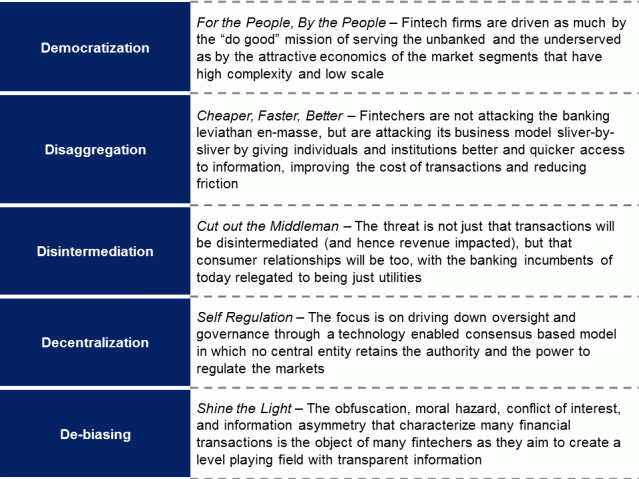 Finance, as the adage goes, is the art of passing money from hand to hand until it finally disappears. Like giant spiders in the middle of a system of webs, banks have played a key role in intermediating money flows across the vast capitalistic system, and doing so in a highly profitable manner. Banking from yore – taking deposits from customers and making loans to borrowers – has given way to a lending system that is dominated by non-banking financials institutions and capital markets. This “banking disintermediation” – banks no longer holding the loans they originated on their balance sheets but selling them off; borrowers going directly to the capital markets rather than to banks to obtain a credit; or savers investing directly in securities – refers to credit disintermediation and has been in the making for a number of decades: banks moved from the boring low-profitability business of credit provisioning to high margin fee-based businesses (investment banking, M&A, insurance etc.). “Disintermediation” – the third theme in The Five D’s of Fintech – has taken on a renewed significance in the wake of the rising tide of fintech: this time around, it refers to how banks may potentially be disintermediated from their customers in their fee-based businesses. Customer relationship, the bedrock of origination and sales that dominates such fee-based businesses, is now under attack, and banks have started to take note.
Finance, as the adage goes, is the art of passing money from hand to hand until it finally disappears. Like giant spiders in the middle of a system of webs, banks have played a key role in intermediating money flows across the vast capitalistic system, and doing so in a highly profitable manner. Banking from yore – taking deposits from customers and making loans to borrowers – has given way to a lending system that is dominated by non-banking financials institutions and capital markets. This “banking disintermediation” – banks no longer holding the loans they originated on their balance sheets but selling them off; borrowers going directly to the capital markets rather than to banks to obtain a credit; or savers investing directly in securities – refers to credit disintermediation and has been in the making for a number of decades: banks moved from the boring low-profitability business of credit provisioning to high margin fee-based businesses (investment banking, M&A, insurance etc.). “Disintermediation” – the third theme in The Five D’s of Fintech – has taken on a renewed significance in the wake of the rising tide of fintech: this time around, it refers to how banks may potentially be disintermediated from their customers in their fee-based businesses. Customer relationship, the bedrock of origination and sales that dominates such fee-based businesses, is now under attack, and banks have started to take note.
Fintech led disintermediation has been palpable in areas where venture investment has traditionally poured into: peer-to-peer lending, remittances, payments, equity crowdfunding and even robo-advisory. Fintech use cases on disintermediation of traditional payment players are old news. By comparison, the impact of fintech led disintermediation of the banks in capital markets appears to be relatively small. By some estimates, only $4 billion of the $96 billion (around 4%) of the fintech investment since the beginning of the millennium has been directed to capital markets, and of 8000+ fintechs globally, only 570 (around 7%) are operating in capital markets (Fintech in Capital Markets: A Land of Opportunity).
This may be beginning to change not least because of the juicy returns that can potentially be plucked from the investment banks in origination and sales (which is the key activity in fee based business such as investment banking, M&A/payments, asset management etc.) which at an estimated 22% ROE (Cutting through the noise around financial technology), is a much more profitable business than credit provisioning (which is the key activity in core banking (lending, deposits, etc.)) with an estimated ROE of only 6%. Entry barriers to capital markets and investment banking are significant: the highly regulated nature of the business, the oligopolistic nature of the industry, vicious competition from incumbent banks, and complex operating environment. However, regulatory pressures, compressed margins and technology enabled opportunities are forcing incumbent banks to acknowledge fintech led opportunities.
The investment banking world is being buffeted by the forces of digitization, regulation, and competition. Continued electronification of OTC markets, for example, has meant greater transparency around the price discovery process for investors. Dealers have pulled back from markets where regulatory requirements have rendered them unprofitable for those banks, thus providing an opening wedge for non-bank players such as hedge funds and institutional investors to step in. The financial crisis has tarnished banks’ reputation. It is against this backdrop that fintech outfits are evolving from just providing solutions to automate and streamline bank transactions to being serious threats across asset classes (equity/debt/FX), markets (primary/secondary), and the value chain (origination through distribution and dealing). In the world of supply chain financing, technology-led disintermediation has begun to make inroads. Regulatory pressures, decreasing margins, and KYC/AML challenges have made it difficult for commercial banks to scale their supply chain finance business: the market is underserved and rapidly growing. This is changing with the emergence of such platforms as PrimeRevenue, an American supply chain financing platform, that connects 70 lenders, including 50-odd banks, to 25,000 suppliers with $7bn-worth of invoices a month. While such platforms are not overthrowing banks’ supply chain financing business completely, they are slowly but surely intermediating themselves into direct relationships with end customers: witness how C2FO has offered Citi more lending opportunities in return for access to its supply chain financing customers.
The origination market for new securities issuance is an area where incumbents are still strong but evolving conditions may favor fintech led innovation. Some large asset managers want to ensure that corporations structure securities that those asset managers want to buy, not necessarily those that a bank may structure: this may just be the kind of solution a fintech may develop. Platforms that connect investors directly with issuers are few and far between in the equity and debt primary markets, and even those that are there have dealers in the mix, but slowly and surely there outfits such as Origin (a private placement platform aiming to simplify and automate the issuance of Medium Term Notes) and Overbond (a Canadian platform provider aiming to streamline bond issuance for both private- placements and public offerings) that are going to market with automation and auditing solutions today, but which may in the future choose to intermediate themselves more prominently with investors and issuers by offering data assets and related value added services.
There are, however, more worrisome developments for banks in the securities origination market. Investors are discovering new avenues for investing, for example equity crowdfunding, which may affect bank’s traditional business in private placements and investment banking payments. There are indications that institutional investors have already started to use crowdfunding websites to gain stakes in new businesses, such as in the real estate sector. One website, for example, enables crowdfunders to pool their capital and compete with institutional investors or co-invest with venture capital funds. There is a perceived threat that more buy-side firms will tap crowdfunding sites. Most worrisome for banks is perhaps the specter of alternate fund raising models whereby conventional IPO gives way to alternate intermediated mechanisms such as electronic auctions, crowdfunding and initial coin offerings (ICOs).
New capital raising models represent the latest in how disintermediation is playing out at the very heart of the capitalistic system. Equity crowdfunding has the potential to disintermediate early stage financing and democratizing access to capital and investment opportunities (in spite of the regulatory and reporting burdens imposed by the JOBS Act): witness the rise of such platforms as Kickstarter and Indiegogo. Equity crowdfunding has been thriving for a few years now, but it is Initial Coin Offering (ICOs) that has attracted investor attention of late.
In contrast to a traditional venture funding or IPOs where investors typically get a slice of the equity and control in the business, ICOs involve raising money by selling a cryptocurrency – called a “token” – at a discount to investors who can then trade the tokens on a crypto exchange. ICOs are different from traditional fundraising and even equity crowdfunding: they are unregulated, and startups do not have to fork out a slice of their equity. Indeed, ICOs have been on a tear: a quarter of the blockchain investment over the past couple of years (approx. $250 million) has come from ICOs, two recent ICOs (Qtum and OMG) passed the unicorn mark in a matter of mere months, and storied VCs are investing in ICO funded startups (Cryptocurrency Hedge Fund Polychain Raises $10 million). ICOs offer yet another fund raising avenue for startups that are skittish about handing over control to outsiders, those that do not want to go through the regulatory hassle of taking their company public, or those that have been neglected by the market. For the investors, ICOs provide the lure of massive returns (although they are extremely high risk and many are scams).
Capital markets’ “Uber moment” may not be around the corner, but the capitalistic middlemen are going to have to increasingly define what value they bring in light of disintermediated banking models being championed by fintechs. It is not just capital raising where fintech startups are mushrooming, but in other areas of the capital markets as well, for example clearing and settlement where blockchain-based startups are providing capabilities for fully automated settlement without the need for a central counterparty. Symbiont, a New York based blockchain startup has demonstrated how “smart securities” can streamline post trade processing and settlement. This has huge implications for middle/back office functions in banks, and the wider capital market ecosystem including custodians, clearing houses and depository institutions. This redundancy of centralized processing in the fintech utopia will be the theme of the next installment of the 5 D’s of Fintech series.

 “Fintech” (a portmanteau of financial technology that refers to the disruptive application of technology to processes, products and business models in the financial services industry) is coming of age: two of the most prominent Fintechers, OnDeck and Lending Club, have gone public, many more are processing transactions to the order of billions of dollars, and outfits providing market intelligence in fintech are cropping up – there is even a newly minted index to track activity in marketplace lending. Banks are increasingly taking note of the Fintech movement, partnering with startups, investing in them or even acquiring them outright. Venture funding in fintech grew by 300% in one year to $12 billion in 2014. According to the Goldman Sachs’s “Future of Finance” report, the total value of the market that can potentially be disrupted by Fintechers is an estimated $4.3 trillion.
“Fintech” (a portmanteau of financial technology that refers to the disruptive application of technology to processes, products and business models in the financial services industry) is coming of age: two of the most prominent Fintechers, OnDeck and Lending Club, have gone public, many more are processing transactions to the order of billions of dollars, and outfits providing market intelligence in fintech are cropping up – there is even a newly minted index to track activity in marketplace lending. Banks are increasingly taking note of the Fintech movement, partnering with startups, investing in them or even acquiring them outright. Venture funding in fintech grew by 300% in one year to $12 billion in 2014. According to the Goldman Sachs’s “Future of Finance” report, the total value of the market that can potentially be disrupted by Fintechers is an estimated $4.3 trillion.